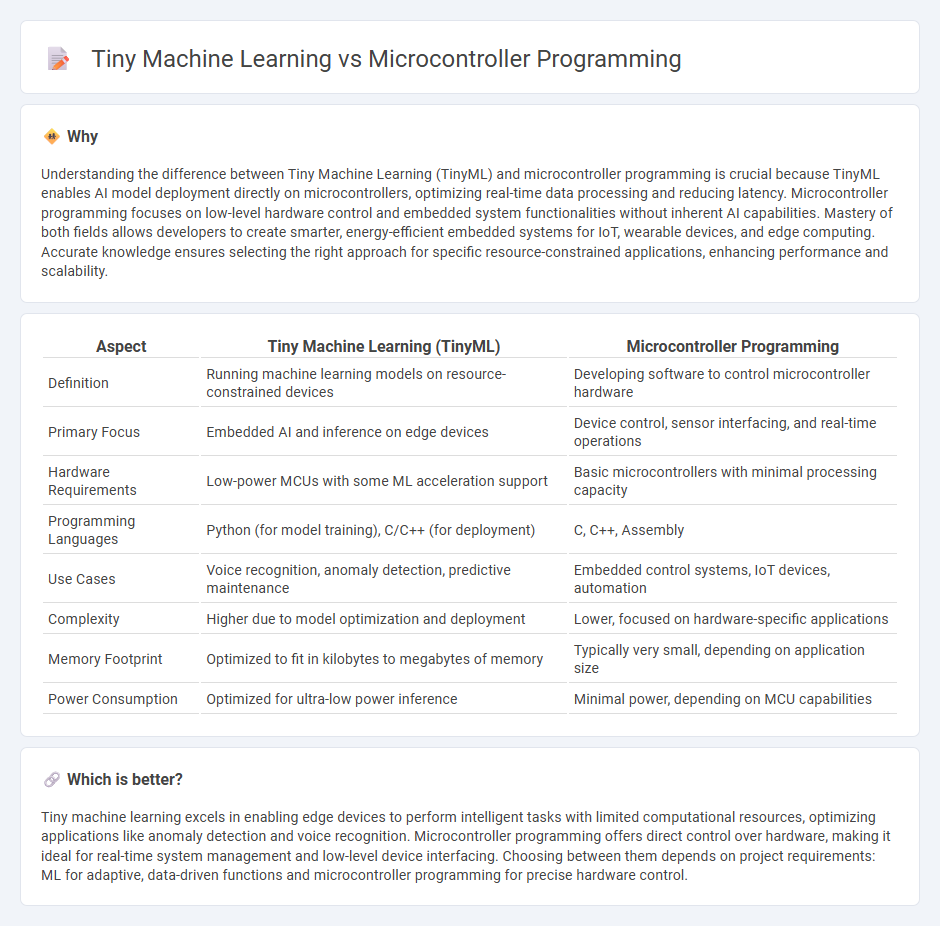
Tiny Machine Learning (TinyML) enables on-device AI inference on resource-constrained hardware, optimizing power efficiency and latency for real-time applications. Microcontroller programming focuses on direct hardware control and low-level system operations, essential for embedded system development. Explore the distinctions and applications of TinyML versus microcontroller programming to enhance your technology expertise.
Why it is important
Understanding the difference between Tiny Machine Learning (TinyML) and microcontroller programming is crucial because TinyML enables AI model deployment directly on microcontrollers, optimizing real-time data processing and reducing latency. Microcontroller programming focuses on low-level hardware control and embedded system functionalities without inherent AI capabilities. Mastery of both fields allows developers to create smarter, energy-efficient embedded systems for IoT, wearable devices, and edge computing. Accurate knowledge ensures selecting the right approach for specific resource-constrained applications, enhancing performance and scalability.
Comparison Table
| Aspect | Tiny Machine Learning (TinyML) | Microcontroller Programming |
|---|---|---|
| Definition | Running machine learning models on resource-constrained devices | Developing software to control microcontroller hardware |
| Primary Focus | Embedded AI and inference on edge devices | Device control, sensor interfacing, and real-time operations |
| Hardware Requirements | Low-power MCUs with some ML acceleration support | Basic microcontrollers with minimal processing capacity |
| Programming Languages | Python (for model training), C/C++ (for deployment) | C, C++, Assembly |
| Use Cases | Voice recognition, anomaly detection, predictive maintenance | Embedded control systems, IoT devices, automation |
| Complexity | Higher due to model optimization and deployment | Lower, focused on hardware-specific applications |
| Memory Footprint | Optimized to fit in kilobytes to megabytes of memory | Typically very small, depending on application size |
| Power Consumption | Optimized for ultra-low power inference | Minimal power, depending on MCU capabilities |
Which is better?
Tiny machine learning excels in enabling edge devices to perform intelligent tasks with limited computational resources, optimizing applications like anomaly detection and voice recognition. Microcontroller programming offers direct control over hardware, making it ideal for real-time system management and low-level device interfacing. Choosing between them depends on project requirements: ML for adaptive, data-driven functions and microcontroller programming for precise hardware control.
Connection
Tiny machine learning enables the deployment of AI models directly on microcontrollers, leveraging their limited computational resources for real-time data processing. Microcontroller programming involves writing efficient, low-level code to optimize memory usage and power consumption, essential for running lightweight machine learning algorithms on embedded devices. This synergy accelerates the development of smart applications in IoT, wearables, and edge computing by integrating AI capabilities into compact hardware.
Key Terms
**Microcontroller Programming:**
Microcontroller programming involves writing code to directly control hardware components such as sensors, actuators, and communication modules, enabling precise manipulation of embedded systems. It requires expertise in low-level languages like C or assembly to optimize performance and memory usage on resource-constrained microcontrollers. Explore deeper insights on efficient microcontroller programming techniques and applications to enhance embedded system development.
Embedded Systems
Embedded systems leverage microcontroller programming to execute specific tasks efficiently with low power consumption, utilizing languages like C and assembly for direct hardware control. Tiny Machine Learning (TinyML) integrates machine learning models within these resource-constrained microcontrollers, enabling local data processing and intelligent decision-making without cloud dependency. Discover more about how TinyML transforms embedded systems by merging AI capabilities with traditional microcontroller programming.
Firmware
Microcontroller programming centers on writing efficient firmware to control hardware operations and manage system resources directly, often using languages like C or assembly. Tiny machine learning (TinyML) integrates machine learning models into microcontroller firmware, enabling AI-powered functionalities within constrained environments without cloud dependency. Explore how firmware development adapts to TinyML to unlock smart, low-power edge devices.
Source and External Links
Microcontroller Programming: Mastering the Foundation of Embedded Systems - This article explores the techniques and foundations of microcontroller programming, including interrupts, timers, and communication protocols like I2C and UART.
Microcontroller Embedded C Programming: Absolute Beginners - This course is designed for beginners to learn microcontroller programming using the C language, covering critical concepts such as bitwise operators and memory-mapped registers.
The Basics Of Microcontroller Programming - This tutorial provides a comprehensive introduction to microcontroller programming, including software selection, compilation, and uploading code to the microcontroller.
 dowidth.com
dowidth.com